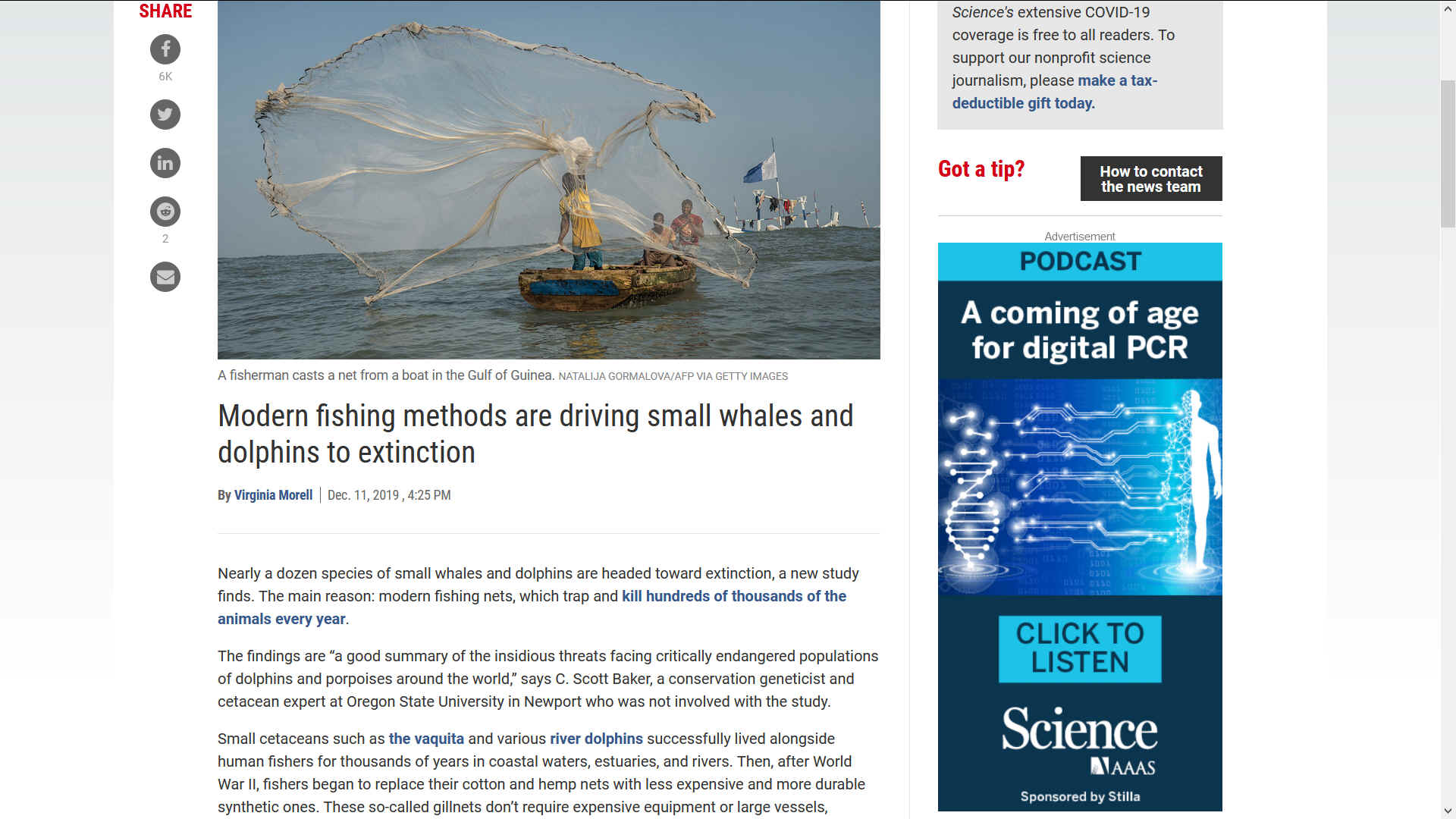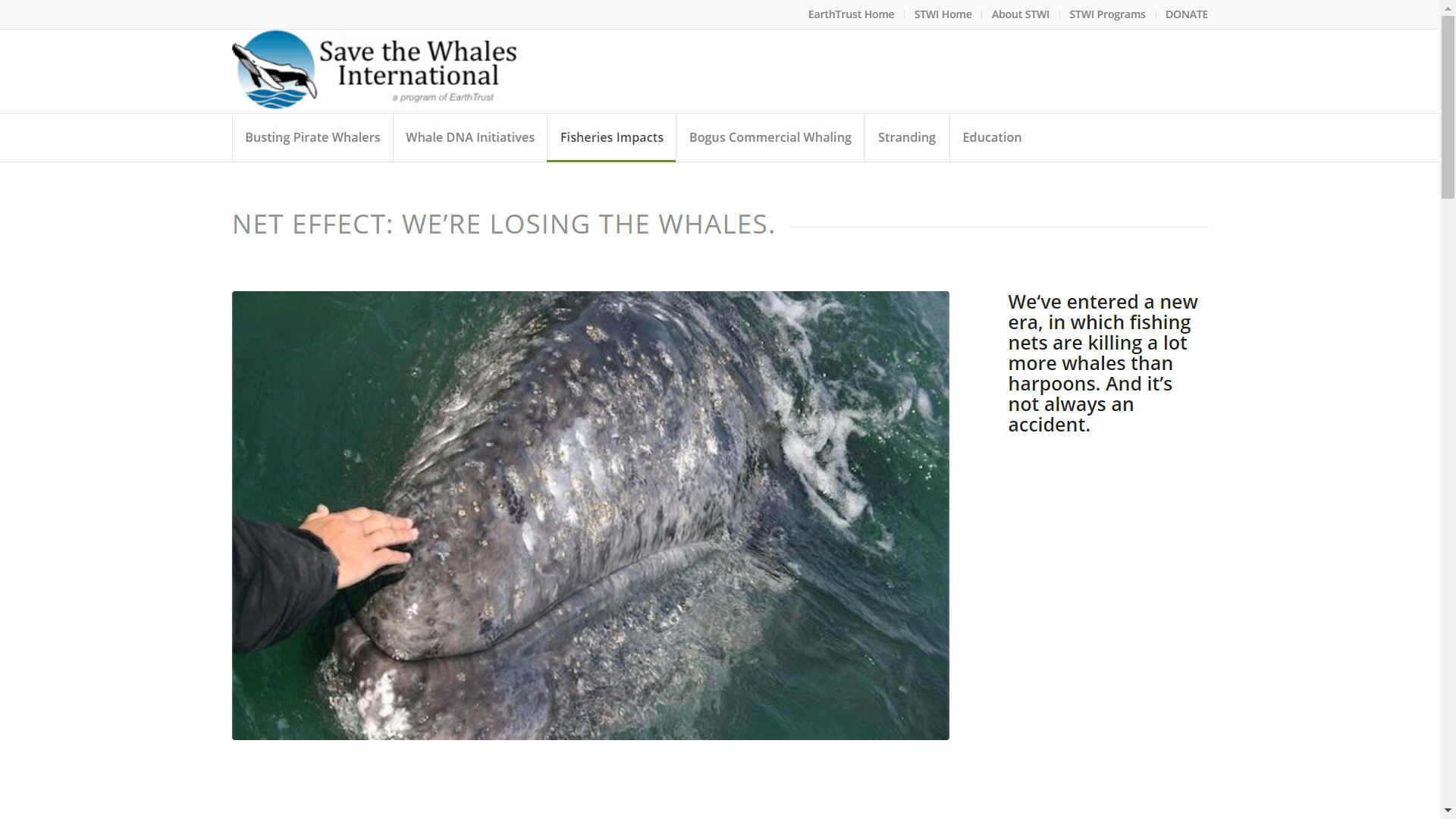
....
Whales used to exist in the seas by their millions, before
humans shot them in the backs with exploding
harpoons when rising to the surface to breathe
air.
These animals had no chance at all once whalers started using sonar to track them underwater.
Wherever a whale surfaced to breathe, the harpoon cannon was waiting.
The advent of sonar sealed their fate absolutely. The whales have no
chance of escaping.
Evolution is too slow to react to such hunting tactics, and their intelligence
cannot save them from this kind of slaughter, because every animal needs to breathe.
SCIENCE
MAGAZINE DEC
2019
Nearly a dozen species of small whales and dolphins are headed toward extinction, a new study finds. The main reason: modern
fishing
nets, which trap and kill hundreds of thousands of the animals every year.
The findings are “a good summary of the insidious threats facing critically endangered populations of
dolphins and porpoises around the world,” says C. Scott Baker, a conservation geneticist and cetacean expert at Oregon State University in Newport who was not involved with the study.
Small cetaceans such as the vaquita and various river dolphins successfully lived alongside human fishers for thousands of years in coastal waters, estuaries, and rivers. Then, after
World War II, fishers began to replace their cotton and hemp nets with less expensive and more durable synthetic ones. These so-called gillnets don’t require expensive equipment or large vessels, making them especially attractive to small-scale fishers worldwide. But cetaceans (as well as other marine mammals and sea turtles) can’t bite through the nets if caught in them, as they could with the cotton nets.
Conservationists have tried for at least 30 years to develop nets that the animals can avoid or easily escape, but they have yet to come up with a good solution. They have also urged governments to enact strict regulations and outright bans on the use of gillnets, but these are typically difficult to enforce.
Now, 11 small cetacean species are nearing extinction primarily because of these nets, marine biologists report this month in Endangered Species Research. Using data collected by
fishing authorities who have recorded population sizes, trends, and the rates at which cetaceans are caught up in nets meant for
fish, the team finds that China’s baiji river dolphin is “almost certainly extinct”; Mexico’s vaquita porpoise, which numbers fewer than 19, is “on the very brink of extinction”; and long-term prospects for West Africa’s Atlantic humpback dolphin are “grim.” The outlook is also poor for a subspecies of the Māui dolphin found only off the southwest coast of New Zealand’s North Island, as well as for the Taiwanese humpback dolphin, the Yangtze finless porpoise, three species of Asian river dolphins, and the
Baltic Sea harbor porpoise. In each case, gillnets were the biggest threat.
Many of these species will vanish unless gillnets are eliminated, says Robin Baird, a marine biologist and cetacean expert with Cascadia Research Collective in Olympia who was not involved with the study. But that will take “political courage,” he stresses, because governments will have to make unpopular decisions, such as enacting no-fishing conservation zones and enforcing strict bans. Unfortunately, he says, at this point that is the only way “to keep these species and populations from going extinct.”
STEALTH
(PIRACY) POACHING
But with whale hunting being banned, a new means of harvesting them has begun. Instead of openly shooting the defenseless animals, nets can be set in suitable locations. Then when a whale is caught, the
pirate whalers can claim it was an accident.
Basically,
pirate whaling appears to have taken a different route. This has
developed from real accidents, where whales have been caught in
genuinely discarded or lost fishing nets.
It
did not take long for illegal whalers and fishermen, after dolphins and
whales, to work out that they could deliberately set nets as traps for
high value cetaceans, then claim it was an unfortunate accident, that
they just happened upon. Because, snagged cetaceans may be legally eaten
in many countries. But should that remain open as a legal loophole?
REASONABLE
COMPROMISE
This was originally considered a reasonable compromise – if a whale has legitimately died in ghost nets, or is so badly injured that it can’t be saved and released, so why “waste” it?
You can imagine that with individual whales worth tens of thousands of $dollars, it can be worth a lot more to snag a whale than to catch fish with nets. So increasingly, the whalemeat trade is being supplied by this bogus “accidental” take, that to our mind is more treacherous, than pirate whaling with harpoons - in that the culprits are causing death by drowning.
And nets, by their nature, are even less selective than harpoons. There is no way to keep highly endangered whale species out of nets. Whatever swims into the net is what you snare.
This
is/was the subject of campaign by the Earth Trust and their Save
The Whales International project starting in 2014.

..
LINKS
& REFERENCE
https://www.sciencemag.org/news/2019/12/modern-fishing-methods-are-driving-small-whales-and-dolphins-extinction
Please use our
A-Z INDEX to
navigate this site

